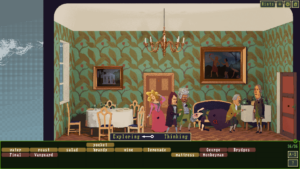14 Minesweeper Variants
I’ve got just one more recent acquisition I’d like to describe before getting back to unfinished business. 14 Minesweeper Variants is exactly what it says on the tin, but also more than that.
Before I get into detail about the variants, I’d like to take a moment to praise it simply as a Minesweeper implementation. It’s got all the UI conveniences you could wish for in a modern spatial logic game, such as highlighting neighboring cells on rollover and dimming numbers that can no longer affect anything. It even gives you a little freeform paint interface so you can take notes on the grid. The only other similar game I’ve played with integrated paint is Tametsi1The word “tametsi” sounds Japanese to me, but it’s not. Apparently it’s Latin for “although”., a sort of Minesweeper/Picross hybrid with puzzles that exploit non-square grids, and I think I overall prefer 14MV‘s version. Also like Tametsi, 14MV never gives the player puzzles where guesswork is necessary, the bane of the usual randomized Minesweeper. There’s some suggestion that the puzzles here are still randomly generated: each comes with an ID number, and you can request puzzles by ID, just like in Freecell. Plus, the credits list a solver algorithm, which seems like it would only be useful for procedurally-generated puzzles — or maybe it’s just used for the hints? The hint system is so good. When you request a hint, it highlights one or more squares that you can figure out, along with the squares relevant to figuring it out and any special rule variants needed, but still leaves it up to you to actually apply this information.
One more thing worth noting: In contrast to both Tametsi and vanilla Microsoft Minesweeper, these puzzles are small. The smallest ones are 5×5 and even the largest are just 8×8. The smallest size Microsoft offers is 9×9. This is to the game’s benefit, if you ask me. And even at these small sizes, an 8×8 puzzle feels qualitatively different from a 5×5 one, giving a significantly different ratio of edge squares to interior.
Larger sizes are unlocked one by one as you finish quotas of puzzles, and so are the variants, giving a nice sense of progression along two axes. The variants included are well-chosen — they’re all fairly elegant, and each requires you to adjust the way you think about the puzzle in a different way. A few examples: There are no completely empty 2×2 blocks. There are never three mines in a row, orthogonally or diagonally. The numbers given are all either one more or one less than the actual number of adjacent mines. Instead of counting mines, the numbers indicate the total number of empty spaces directly north, south, east, and west until the first mine. All the empty spaces form a single orthogonally-connected group and all the mines are in groups connected to the edge. If you’re a fan of Nikoli-style Japanese spatial logic puzzles, some of these rules may sound familiar. It kind of feels like the game’s thesis is that Minesweeper is essentially part of that family, and that the only thing that keeps it from being normally classed with them is that it relies on hidden information, and thus cannot be done purely in print.
Of the fourteen variants, seven alter what the numbers in a square mean, and seven place additional restrictions on the arrangement of mines in the grid. It took me a long time to notice this, even though the puzzle selection menu clearly indicates the two groups as two parallel columns, each in its own independent unlock sequence. But this distinction becomes very important in the endgame, when the game starts combining variants. This is where things get magical. You get puzzles that use one rule from each column, a number rule and a mine-placement rule. You get puzzles where the number rule varies from clue to clue, indicated by a letter in the cell in addition to the number. And finally, you get both at once, puzzles with both a mine-placement rule and varying number rules. And it all feels like this is what you were training for by doing the individual variants, which seem so simple now. It isn’t really that the puzzles get harder per se — if anything, throwing in a mine-placement rule means adding constraints, which lets you do more with less information. But it greatly increases the number of things you have to take into consideration to make progress.
Now, there have been a lot of games based on Minesweeper, albeit few noteworthy ones. And usually they don’t have any good ideas for improving on the original. Mostly what you see is the addition of powerups — limited-use tools that let you break the rules in some way, surviving mine explosions or peeking at squares or whatever, valuable for eliminating ambiguity created by random mine placement but ultimately weakening the puzzles as puzzles. I’ve seen Minsweeper with realtime elements, Minesweeper with RPG leveling, Minsweeper with interstitial narrative. All in pursuit of giving a sense of progression, something to give the player an experience that’s more than just an isolated puzzle. And I’ve never seen any of them do that as effectively as this, the least flashy and most competent of Minesweeper games.
| ↑1 | The word “tametsi” sounds Japanese to me, but it’s not. Apparently it’s Latin for “although”. |
|---|
 Comments(0)
Comments(0)